Podcast: Play in new window | Download (Duration: 26:45 — 33.4MB)
Subscribe: Apple Podcasts | Spotify | Amazon Music | Android | Pandora | iHeartRadio | JioSaavn | Podcast Index | Email | TuneIn | RSS | More
By Davy Crockett
You can read, listen, or watch


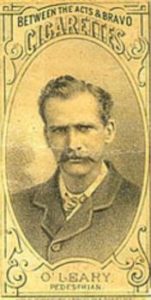

All the racing was taking a toll on O’Leary, and he had frequent thoughts about retiring. However, he still had obligations as the holder of the Astley Belt and the title of Champion of the World. If he could defend the Astley Belt one more time, three wins in a row, by rule he could keep the belt. A Third Astley Belt Race was in the early planning to be held sometime during the summer of 1879. In January he went to Arkansas to rest at the famous hot springs with its six bathhouses and 24 hotels.
Little did he know that the Third Astley Belt Race would be one of the most impactful spectator events in New York City 19th century history witnessed by more than 80,000 people. It impacted ten of thousands of workers’ productivity for a week and even distracted brokers on Wall Street away from their ticker tapes. The major New York City newspapers included more than a full page of details every day that revealed the most comprehensive details ever of a 19th century six-day race. Because of its historic importance, this race will be presented in two articles/episodes.
| Please help the ultrarunning history effort continue by signing up to contribute a little each month through Patreon. Visit https://www.patreon.com/ultrarunninghistory |
Astley Backs a Potential British Champion
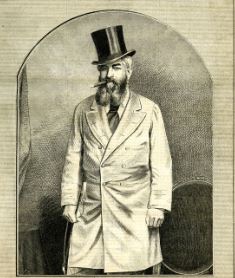

Sir John Astley wanted to make sure a Brit would next win the belt. After putting on an English Championship in late October 1878, he identified the best British candidate that he thought could contend with O’Leary and bring the Astley Belt back to England. His man was Charles Rowell, who had recently placed third in Astley’s English Championship Six-Day race with 470 miles. Astley formally issued a challenge to O’Leary on behalf of Rowell.
Charles Rowell
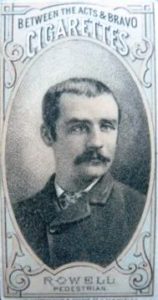

When Edward Payson Weston first came to England in 1876, Rowell raced against him in a 275-mile track race in the Agricultural Hall in London. He mostly played the role as a pacer and completed 175 miles to Weston’s 275 miles.
Astley charged Rowell to get himself fit and promised to pay the expenses for him to travel to America for the Third Astley Belt Race. After a few weeks of training, Astley invited Rowell to his estate and observed his running abilities. “I was satisfied that he was good enough to send over to try and bring back the champion belt to England.” He provided £250 for his expenses. Prior to leaving England, it was rumored that he had covered a world record 539 miles in a private six-day trial, but Rowell would not confirm or deny it.
Third Astley Belt Scheduled
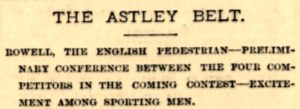

Clearly Astley believed that Rowell was ready to be sent to America and didn’t want to wait until June. O’Leary’s camp stated that Astley wanted to hurry up the match because he believed O’Leary was out of shape after his match with Campana a month earlier that really trashed his feet and overall health (see episode 107). But the Chicago newspaper countered, “If this is the case, they are much mistaken. O’Leary is all right.”
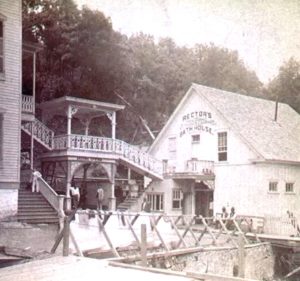

O’Leary, who was still at the hot springs in Arkansas, thought the decision was unfair and arbitrary, but he knew he couldn’t fight it. He wasn’t going to lose the belt over a scheduling battle. With the surprising announcement, it also gave other Americans, such as George Guyon, only five days to send their entrance fee to London. No additional runners entered in time. Astley was a shrewd, determined character. O’Leary gave in and said, “I am ready to walk at two days’ notice.”
Rowell Arrives in America
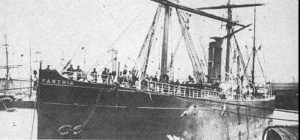

In mid-February, Rowell boarded the steamship Parthia for New York City with a sendoff by Astley who made sure the captain of the ship gave him great accommodations.
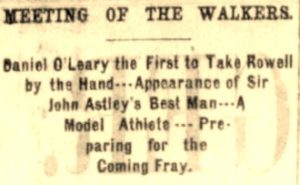

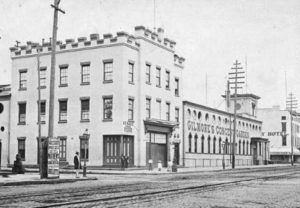

Rowell walked to Gilmore’s Garden to look at the venue of the race and then walked downtown to the St. James Hotel to have a runners’ meeting with O’Leary, Harriman, and Ennis. Ennis had recently arrived from Chicago after a terrible road trip was delayed enroute for two days because of heavy snow. They negotiated the division of the resulting gate money and set firmly the start date for the race to be March 10, 1879. Good feelings were felt. Ennis joked that Harriman, who was over six feet tall, was too tall to walk against the three other shorter men and suggested that he should be cut down to regulation length.
John Ennis
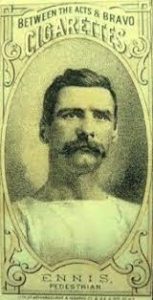

Ennis was a veteran of several six-day races, but he usually came up short due to stomach problems. Many in Chicago had turned against him. “Is it not about time that this man should end his nonsensical talk? He has made more failures than any known pedestrian in this country.” His pre-race bio included: “John Ennis of Chicago, a remarkable, but unlucky pedestrian, who on several occasions, with victory almost in his grasp, has been forced to leave the track through sickness.”
In 1878, Ennis finally started to taste success. He won a six-day race in Buffalo, New York, but only reached 347 miles. Then he finally had good success walking six days in September 1878, again at Buffalo. He won with 422 miles. The next month he went to England and raced against Rowell and others in the English Astley Belt Race where he finished 5th with 410 miles.
Charles Harriman
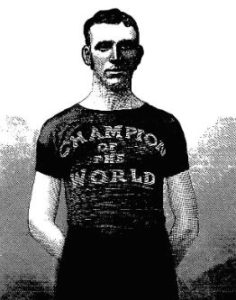

Charles A. Harriman (1853-), age 25, was a shoemaker, originally from Maine but living in Haverhill, Massachusetts. He began his running career in 1868 in short sprinting races. His ultradistance experience was recent, but impressive, breaking the existing walking 100-mile world record with a time of 18:48:40. With no six-day experience, he entered the next Astley Belt Race and was accepted.
Harriman had trained hard for the race. His pre-race bio included: “Charles A. Harriman, the dark horse of the lot, though a novice in six-day contests, has a remarkable record as a 24- and 36-hour walker.” He predicted that he would cover 125 miles during the first 24 hours.
Runners Preparations for the Race
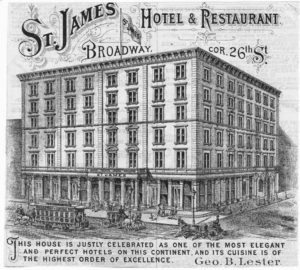

A week before the race Rowell and Ennis trained together in Central Park. Harriman walked on the city streets for several miles and spent a bit too much time flirting with the beautiful wife of the St. James Hotel steward, who he would run away with in the coming months, causing a big scandal. O’Leary took it easy, made no predictions, and went to Gilmore’s Garden to watch Rowell run.
New York was curious about the Englishman. “Rowell is the smallest man of the four candidates and now weighs about 140 pound in costume. His style of progression is a trot, yet he moves along with little apparent exertion. Very solidly built, Rowell seems capable of bearing much fatigue, and judging from his conversation, he is hopeful of winning.” Rowell said, “I am not a walker. I know how to run, but I am a poor walker.”
Gilmore’s Gardens Prepared




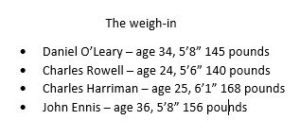

Police officers would be stationed to prevent spectators from interrupting the competition. A huge blackboard was placed in the center of the building for every mile to be promptly posted. A box near the Madison Avenue entrance was designated to be the telegraph office and wires were run to the Western Union Building. Messages would be sent to England directly from the track. Fires from seventeen furnaces would warm the building. Huts/cottages were provided for each man and their crews. They were ten-by-eleven feet, and each was furnished with gas stoves, comfortable beds, and plenty of cooking utensils.
The Wild Start


As thousands of people were pouring into Gilmore’s Garden, the contestants arrived at midnight, greeted by 4,000 people, and shut themselves in their little huts, away from the confusion, to prepare. With a half hour to go, the crowd was surging back and forth and there was still a mass of people outside wanting to get in. The police did their best to hold off a rush through the door. The Astley Belt was put on display at the judges stand. The runners came out and rules were read. The runners could reverse direction at a mile mark and the runner going counterclockwise had the inside right-of-way. “Meanwhile the great crowd was as noisy and unruly as possible and the brass band in attendance could hardly drown the noise made by excited betters.”
Off They Go


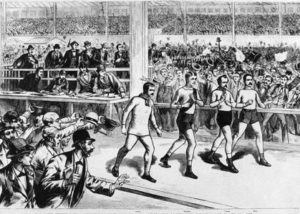

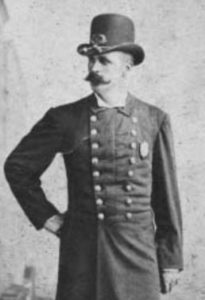

Then it happened! When the first mile was announced on the blackboard with a time of 9:25, the cheering was deafening. Those who were left outside the building, heard the roar. The outside crowd turned into an angry mob and rushed for the entrance, overwhelming the two policemen out there, broke down the door off its hinges and pushed into the building.
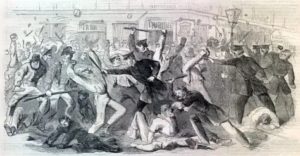

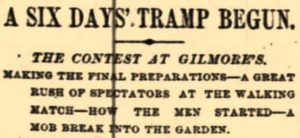

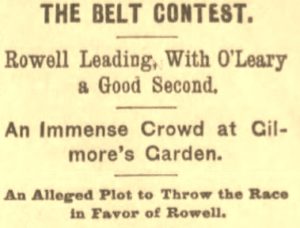

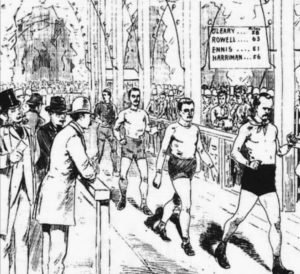

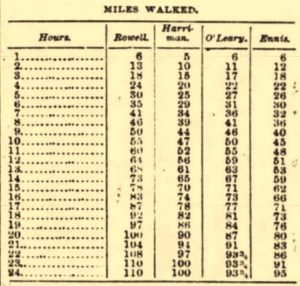

A strange rumor was circulating that one of O’Leary’s trainers, the pedestrian William Edgar Harding (1848-), editor of the National Police Gazette, was plotting to poison O’Leary on day four. O’Leary dismissed the charge as ridiculous and kept Harding on this team.
At the end of day one, the score was Rowell 110 miles, Harriman 100, Ennis 95, and O’Leary 93. Before the race, O’Leary was the favorite among betters, but now Rowell was the favorite.
Day Two
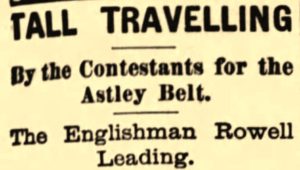

The race captured the imagination of New York City. Bulletins were displayed and kept updated out in the streets that attracted crowds of eager news seekers. “Such general interest in a match of this kind has never been excited in this or any other city. It is the one theme of town talk, and the throngs that haunt the scene of the contest at all hours of the day and night are unprecedented.”
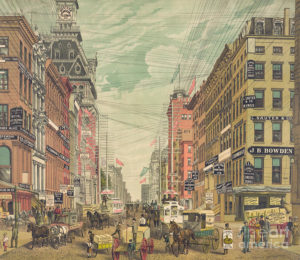

Boys who could not afford a ticket would use their jackknives to cut holes through a wall panel of Gilmore’s Garden to get a peek at the action inside.
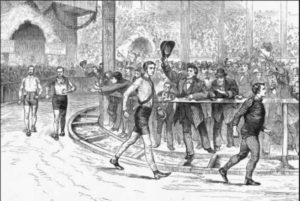

Rowell started to be referred to as the “little feller,” and did many long runs. His handlers spent most of their time “concocting mysterious drinks and messes over the small gas stove that occupies one corner of the apartment.” They were very secretive and would not answer questions about how Rowell was doing.
The tall Harriman kept up a tremendous pace with a great swinging stride at “the untiring regularity of a machine.” He started to receive the nickname “steamboat.” Ennis was called, “Honest John” by his friends. While on the track, he would do a lot of running.
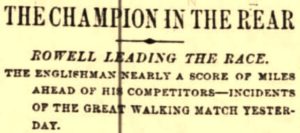

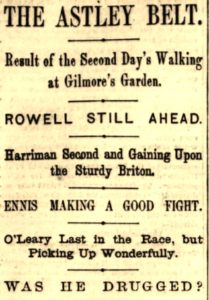

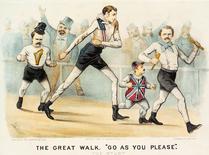

As midnight approached, a gang of gate crashers used a beam of wood as a battering ram to break down a door to get in the building. Police eventually rounded them up, arrested them, took them out of the building, beat them, and then let them go.
At the end of day, 48 hours, the score was Rowell 197 miles, Harriman 186, Ennis 173, and O’Leary 164.
Day Three
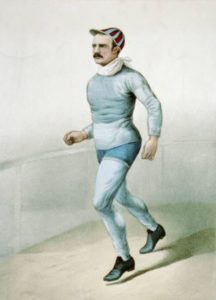

The crowd thinned out during the early hours of day three. A few made beds for themselves from seats. “The spectators wore a subdued look, some having their eyes closed in slumber and others yawning at frequent intervals.” Dawn arrived and the tired runners were back on the track.
In the afternoon, Rowell tried to use his shadowing strategy on Harriman, running close on his heels. Harriman said, “It didn’t bother me. I heard the Englishman puffing pretty hard, that is all.” The crowd didn’t like watching these dogging antics from Rowell and yelled at him, “There’s Harriman’s bull pup, come here little doggy.” They encouraged Harriman to get a leach for his new dog. Then to Rowell, “Why don’t you jump up on his shoulders? Get him to tote you around little boy!”
O’Leary Breaks Down
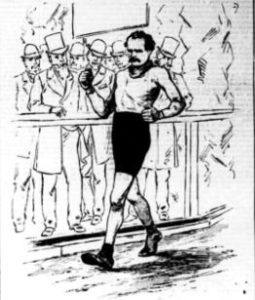

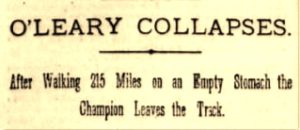

He still tried to plod along courageously, but during mile 216, he had to stop three times. He was about 35 miles behind Rowell. O’Leary was seized with violent pains and strange sensations that made some believe that a trainer had poisoned him. The crowd was hopeful that he would return and in unison gave three cheers for O’Leary.
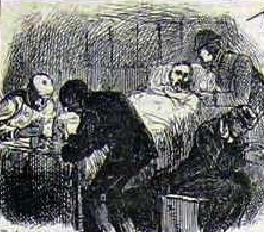

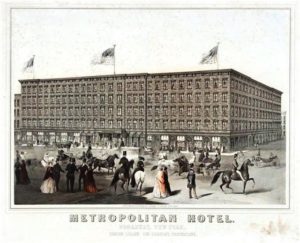

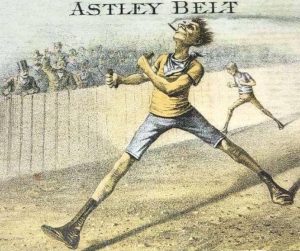

O’Leary’s doctor was asked why O’Leary broke down so soon. He blamed it on his trip to the Hot Springs which softened up his feet. “Then the atmosphere in this Garden was simply rank poison, as bad as arsenic. At every breath he got a mouthful of dust, smoke, and stale air.”
O’Leary would not win the Astley Belt for the third time in a row and thus could not claim it permanently. It would have a new steward.
At 4 p.m. on day three, the score was Rowell 250 miles, Harriman 238, Ennis 223, and O’Leary 215.
Stay tuned for the exciting conclusion of the Third Astley Belt in Part 15/Episode 109.
The parts of this Six-Day Race series:
- Part 1: (1773-1870) The Birth
- Part 2: (1870-1874) Edward Payson Weston
- Part 3: (1874) P.T. Barnum – Ultrarunning Promoter
- Part 4: (1875) First Six Day Race
- Part 5: (1875) Daniel O’Leary
- Part 6: (1875) Weston vs. O’Leary
- Part 7: (1876) Weston Invades England
- Part 8: (1876) First Women’s Six-Day Race
- Part 9: (1876) Women’s Six-day Frenzy
- Part 10: (1876) Grand Walking Tournament
- Part 11: (1877) O’Leary vs Weston II
- Part 12: (1878) First Astley Belt Race
- Part 13: (1878) Second Astley Belt Race
- Part 14: (1879) Third Astley Belt Race – Part 1
- Part 15: (1879) Third Astley Belt Race – Part 2
- Part 16: (1879) Women’s International Six-Day
Sources:
- Matthew Algeo, Pedestrianism: When Watching People Walk Was America’s Favorite Spectator Sport
- Tom Osler and Ed Dodd, Ultra-marathoning: The Next Challenge
- P. S. Marshall, King of Peds
- The Croydon Advertiser (London, England), Jul 10, 1875
- Chicago Tribune (Illinois), Apr 14, 21, Jul 19, Oct 8, 1878, Mar 2, 10, 1879
- Manchester Evening News (England), Feb 20, 1879
- The Buffalo Commercial (New York), Nov 29, Mar 4, 1878
- Buffalo Morning Express (New York), Jan 1, 1879
- The Boston Globe (Massachusetts), Jan 6, 26, Mar 1, 4, 8, 10, 1879
- New York Daily Herald (New York), Jan 30, Mar 1, 3-4, 9-16, 1879
- The Lancaster Gazette (England), Feb 19, 1879
- The Brooklyn Union (New York), Mar 1, 1879
- Rutland Daily Herald (Vermont), Mar 4, 10, 1879
- Public Ledger (Memphis, Tennessee), Mar 5, 1879
- Hartford Courant (Connecticut), Mar 11, 1879
- The New York Times (New York), Mar 8, 10-11, 14-16, 1879
- New-York Tribune (New York), Mar 8, 1879
- The Brooklyn Daily Eagle (New York), Mar 10, 1879
- Chicago Daily Telegraph (Illinois), Mar 10, 1879
- The Boston Weekly Globe (Massachusetts), Mar 11, 1879
- The Graphic (London, England), Mar 22, 1879
- Sheffield Independent (Yorkshire, England), Apr 3, 1879
- Aberdeen Evening Express (Scotland), Apr 4, 1879
- The Cincinnati Enquirer (Ohio), Apr 4, 1879
